Orgelkonsertinn, Dettifoss, Tilbrigði við stef eftir Beethoven og Fine II
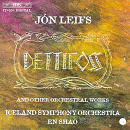
We've been waiting for this for a long time, we small but growing brotherhood of enthusiasts for the music of Icelandic composer Jón Leifs (1899-1968)--and it's even better than we had hoped. Organ concertos tend to be monumental affairs, and most of Leifs's compositions are monumental in a way that leaves most other composers looking like sissies. Word had gotten out that Leifs's Organ Concerto was indeed a massive affair of elemental power--and so it proves, stunningly so. My Fanfare deadline was coming up, and there were still several discs left to deal with--but a pneumatic drill busy in building works outside my flat was making listening difficult. No problem for Leifs: On with the Organ Concerto, and up with the volume! By god it's loud, and by god it's exciting, in the kind of unarguable way that lava flows and earthquakes are exciting (people writing about Leifs are often driven back to this kind of simile: Only the natural world at its most violent offers a range of images that can do the music justice). The Concerto was begun in 1917, when he was 18, and worked on it, on and off, for the next 13 years. Formally, it's a passacaglia with 30 variations, preceded by an introduction and rounded off with a finale. But the sound it makes is far less conventional. To begin with, the passacaglia theme contains all 12 pitches, though it is not dodecaphonic as such; then Leifs uses clusters in his harmonies, which can make the music searingly dissonant, although a diatonic smile occasionally pokes through the storm. And it's not all bang, crash, and upheaval: There are passages where calm seems to be established, though one is always conscious of the growing power of the music continuing to evolve under your feet--if you've ever stood above subterranean volcanic or thermic activity, you'll know the feeling of just-constrained energy I mean. In the finale the concerto builds up to an overwhelming climax, massive chords of intemperate savagery blasting out from the organ in dialog with timpani and brass, as if the music was trying to push mountains out of the way.
The middle two works on this disc are somewhat calmer. The Pastoral Variations, op. 8 (1920), on a D-Minor theme from Beethoven's op. 8 Serenade for violin, viola, and cello, begins calmly enough at first, Leifs doing little more than caress the theme. Variation IV is a jaunty little march, and the heraldic Variation VI presages the advent of the powerful, stomping Leifs we know from elsewhere; Variation VIII is a surprisingly lightfooted whirlwind treatment of the theme. The finale reprises Beethoven's original, now opened up in a radiant D Major. Small wonder this is one of the more frequently performed works in the Leifs catalog.
Fine II, op. 56, dates from 1963, five years before Leifs's death. His thoughts were on mortality: Like its companion piece, Fine I, Fine II bears the subtitle "Farewell to Earthly Life," and it's a moving, understated elegy for, one must suppose, Leifs himself. The scoring is pared away to the essential--just strings and vibraphone, the latter hardly used--and the music is devoid of any unnecessary gesture. Apart from Leifs's six-minute Requiem for a cappella chorus, written on the death (by drowning) of his daughter, I know of no piece by him so directly affecting.
With Dettifoss, op. 57 (1964), we are back to Leifs confronting nature. The piece takes its title from the mighty waterfall in the north of Iceland; indeed, it's one of a trilogy of symphonic poems depicting features of the Icelandic landscape. The other two are Geysir, op, 51, and Hekla, op. 52, which perhaps the loudest piece yet written for the concert hall (and you can hear its loudest performance yet on Earquake, a celebration of very loud music on Ondine ODE 894-2). Dettifoss sets a stanza from a poem by Einar Benediktsson, casting a baritone solo as the poet and the mixed chorus as the waterfall. It begins slowly, broodingly, as the poet nears the falls, tempo and volume gradually increasing, until the falls come into view and the chorus intones its granitic hymn, answered by the baritone, over a carpet of growing violence, as if the opening to Also Sprach Zarathustra had been enlisted to bolster the worst efforts of Holst's Mars. Then the poet turns his back on the waterfall, the climax subsides, and we are abruptly left in stillness and silence. It's astonishing to think that a work so primally impressive should have had its premiere only last year, and now appears on a disc that commemorates its composer's centenary.
You really have to have this recording. I can use all the seismic metaphors I like, but you won't really appreciate the sheer brutal excitement of Leifs's music until you hear it yourself. It has something of the immediacy of Varèse--but Varèse seems almost house-trained when you set him alongside Leifs. The performances are heroic, and the sound manages to convey the detail of Leifs's huge canvasses without being overloaded. This one gets a very enthusiastic recommendation indeed. And if you don't get on with your neighbors, you might also find it very useful.
FYI, there's an excellent introductory article on Leifs by John Pickard (himself a composer of powerfully energetic music, although he's only in his mid thirties) in a recent issue of Tempo, the modern-music magazine published by Boosey & Hawkes: No. 208, April 1999, pp. 916. And the most extensive publication, with worklist, discography, etc., that I have yet come across comes (in French) in the most recent Bulletin of the Carl Nielsen Association of France, c/o Jean-Luc Caron, 74 allée des Bocages, 77177 Brou sur Chantereine, France.
Martin Anderson
Íslandskantatan, Íslandsforleikurinn, FineI og FineII 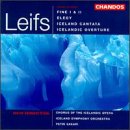
It is somehow appropriate that the founding father of Icelandic concert music, John Leifs (1899-1968), should write in an idiom that is as stylistically stripped down and singular as his isolated, sea-locked island nation is geographically nonpareil. As more and more of Leifs's unique output is revealed on recordings, his connections to a kind of anonymously nonnationalistic and planetary Ur-Musik becomes ever more clear and undeniable.
From his earliest works on, such as the Icelandic Overture of 1930 (heard here for the first time with its string choral finale) and the Icelandic Cantata of 1932 (one of his most moving works in the more traditional sense of sustained eloquence), there exists an element in Leifs's language which can be regarded as totally unaffected and unself-conscious in its authentic primitivism, which is not the same thing as ``naif'' and hence primevalism might be a more accurate term. In any case, he never seems to be aware of writing music which harks back to the earliest emergent musical impulses of homo sapiens: this idiom just comes naturally to him in its immutably monolithic quiddity.
In the later works from his final years -- the Elegy for strings (1960) and the two Fines of 1963 -- his music has acquired a static, hushed quality where conventional thematic and harmonic concerns are almost irrelevant, as if the sounds were part of some natural formation such as a rock or a fern or an ocean. The Elegy, with its open-ended sequence of simple chord patterns reminiscent of early Hovhaness, has a subdued and resigned sense of bereavement, while the two works entitled Fine (or End) have an air of eschatological finality about them, both of them subtitled ``greetings [why not farewell?] to earthly life.'' If, according to the annotation, the Fine I for full orchestra opens with a ``Big Bang birth of the cosmos,'' Fine II is much more withdrawn, even tentative, as it calls only for strings with occasional vibraphone filigree. This work, too, serves as a kind of diminuendo to a life of losses, haunted as it is by the death of the teenage daughter commemorated by the earlier Elegy, but in some respects also beyond grief and certainly beyond hope of any kind.
Given the identity of the forces involved, one must assume these performances are immitigably authoritative. Anyone who has been marked by Baldr (on MCBS) or the Saga Symphony (on BIS) cannot avoid owning this disc. 'Nuff said.
Paul A. Snook
Hafís, tveir söngvar, Guðrúnarkviða, Nótt og FineII 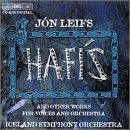
Jón Leifs' music tends to extremes: of volume, ensemble size, harmony, and rhythm. As such, people either love it or hate it. I love it. True, it's a comparatively hermetic, or "closed" style, with a limited range of expressive devices. Harmonic motion follows the parallel fourths and fifths of Icelandic folk music, and rhythms are slow moving but relentlessly asymmetrical. Still, no one expresses the primal qualities of nature better, and this disc perfectly illustrates the fact that Leifs could achieve a wide emotional range by drawing selectively on the various tools in his musical storehouse. The principal work here is Hafís (Drift Ice), the fourth in a series of vast tone poems illustrating the more violent natural forces shaping the craggy terrain of Iceland. The others in the series, all of which have been recorded for BIS, are Hekla (the volcano), Geysír (which depicts exactly what you think it does; the English word comes from the Icelandic), and Dettifoss (a huge waterfall). All four employ large orchestral forces, and three (the exception is Geysír) ask for a chorus as well. Leifs pulls out all the stops in these pieces, asking for massive percussion in Hekla (20-plus players including pistol shots, cannon, sirens, chains, and steel plates), and in Hafís, a huge ratchet to simulate the sound of cracking ice. The music is thrilling, the choral writing all but impossible yet very effective, the slow crescendos to those huge climaxes unforgettable, and if you haven't heard these works, you're missing something very special. At the opposite extreme from Hafís lie the two songs: short settings of evocative poems by Jóhann Jónsson the last of which, "Lullabye", has such an extraordinary, haunting simplicity that it's programmed on the disc twice, once in tandem with its companion, "Moon Song", and once at the very end. Both The Lay of Guthrun and Nótt (Night) are basically concert arias or cantatas for soloists and orchestra, neither impractically scored, which would make an interesting change of pace in any symphony program. Fine I was conceived, along with Fine II, as a possible conclusion to Leifs' monumental oratorio Edda III in the event he did not live to complete this last work in a projected trilogy. In the event, he did die with the work unfinished, and the two "Fine" pieces have since acquired a life of their own among the composer's more attractive short works. Fine I begins with a bang and works its way back up to an angry, fist-shaking ending, all in about three and a half minutes. I had the good fortune to attend the concert at which this music was performed, an occasion commemorating the 100th anniversary of the composer's birth in 1899. It was a moving and extraordinary event, especially when you consider the fact that many of Leifs' works had never been played, including several of these. American conductor Anne anson led a clearly energized Iceland Symphony Orchestra in spectacular performances of the larger scores, and while not all of the vocal soloists made an equally strong impression, they delivered the sense and spirit of the text as only native singers can. Happily, the electricity of that occasion has carried over to this excellent recording, which boasts stunning recorded sound to boot. If you don't yet know Leifs, here's a perfect place to start. |
|
|  |
Sögusinfonían
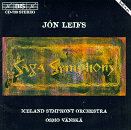
I first learned of the remarkable and unclassifiable Jon Leifs, the chief figure in twentieth- century Icelandic music, by way of Paul Snook's review of an all-Leifs disc in Fanfare 15:2. Visions and Images, a compilation of shortish tone poems for orchestra composed in the late 1950s and early 1960s (ITM 6-04), amply fulfilled Snook's promise of a "totally singular musical experience," once I ventured to the store and put down an outlandish sum for it. These rugged, explosive, percussive, fragmented, unrelentingly dissonant scores sound like no other composer known to me, with the possible exception of Carl Ruggles. Hekla, picturing Iceland's most famous volcano, builds to an almost intolerably dense climax: metal and stone percussion, sirens, clusterlike orchestral sonorities. It is certainly equal in sheer ferocity to any of the avant-garde inventions of this period in Poland or elsewhere, and it makes more musical sense than most of them. Now this BIS disc arrives with the fairly astonishing news that Leifs's style had been fully in place in the early 1940s, when he was trapped inside Nazi Germany!
Leifs's involvement in the Nazi cultural apparatus is a perplexing episode that seems to require a bit more explication than BIS's notes attempt. He had studied in Leipzig starting in 1916 and had met and married a Jewish pianist named Annie Riethof. He stayed in Germany through the 1930s and only returned to Iceland by way of Sweden in 1944, having been barred from leaving earlier. Hjalmar H. Ragnarsson's notes say he kept a "low profile," trying to protect his Jewish wife, children, and in-laws from the Nazi regime. But his profile was a little higher than that: he was a member of the Composers' Council, an organization set up under the titular leadership of Richard Strauss in order to supplant the degenerate-Bolshevist International Society for Contemporary Music. A composer interested in ancient Norse myth and folk melodies of the far northern peoples must have found a dangerously receptive climate in the Germany of the 1930s. Whatever the biographical complexities, Leifs's musical methods themselves were of no use whatsoever to the Nazis. His increasing propensity for dissonance made his music unplayable in the late 1930s. A concession was granted for a single performance of his Organ Concerto by the Berlin Philharmonic in 1941 (who conducted?); it was a spectacular failure, and Leifs withdrew into total isolation to compose his Saga Symphony.
What a colossally strange work Saga Symphony turns out to be. There are elements of a more traditional Scandinavian symphonic sound in it -- certain washes of sound reminiscent of Sibelius, even traces of Grieg-like dances here and there. In the fourth movement there is a fast, slashing, metallic figure that bears an uncanny resemblance to the famous "Saber Dance" in Khachaturian's Gayaneh -- a work that was being composed concurrently in the war-torn Soviet Union. (There was no possibility of influence in either direction.) Otherwise, Leifs's score here and his music in general offer extraordinarily few footholds of familiarity. One of the basic elements of his sound is a reliance on parallel fifths, derived from Icelandic folk music. These fifths inevitably give a medieval tinge to the harmony: the fifths sound very much like medieval organum. But then there is a whole weird harmonic structure built around them that creates sudden jolting movement from plain triads to screaming clusters: as BIS's notes explain, a result of intervals formed from the whole-tone scale, which contains no open fifth and therefore continually grates against the underlying pedal point. The orchestration is as dark as dark can be, with low gro .
ALEX ROSS
Hekla, Íslandsforleikurinn, Requiem, Réminiscence du nord, Svítan Galdra Loftur og Elgy. 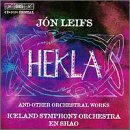
Born in northern Iceland in 1899, Jón Leifs was to become the leading Icelandic composer of the 20th century. He was, however, largely trained in Leipzig, and over the following 30 years spent much of his time in Germany, where he became a well-known conductor. The later part of his life was spent in his native land, and he died in Reykjavik in 1968. Throughout most of that life he composed, the music intended as interludes for Galdra Loftr dating back to the young 15- year-old Leifs, following his presence on the opening night of Sigurjónsson's play. From the original 15 sections, Leifs eventually drew five movements for his suite. He completed the orchestration at the conclusion of his student days in Leipzig. It was a work painted in primary colors, and full of grandiose, youthful effects. The finale certainly makes a forceful impression, the tempestuousness of the music creating a quite dramatic atmosphere.
In 1926 Leifs conducted the Hamburg Philharmonic Orchestra on a tour of Iceland, and for the occasion composed a brilliant and powerful overture. It was to capture the Icelandic landscape and Viking ancestry, its raw vigor in the opening sections concluding with two folk melodies performed by mixed choir and children's chorus. In 1944 Liefs returned to Scandinavia, having lived in Germany during the war years. He had two children, and in 1947 his daughter drowned in a swimming accident. It was a moment of devastation in his life, resulting in the deeply moving Requiem for mixed a cappella choir. Rather than using the Latin text, Leifs used his own. It is short and deeply moving.
In the years that followed he wrote very little, and when he did resume, his music had become more abstract, resulting in the 1952 score for strings, Réminiscence du nord. With the word "north" he was referring to Iceland, and deeply imbedded into his thought process were the Icelandic folk songs of his youth. In 1956 he returned to the descriptive music of his earlier days for Helka, a picture of the volcano's eruption he had witnessed in 1947. In terms of decibels it is one of the most powerful works ever composed. To the enormous battery of percussion Leifs adds small and large rocks, metal chains, sirens, gunshots, and anvils. From the quiet opening the work grows to a quite cataclysmic conclusion, with the brass called upon for feats of virtuosity. Just when you think that he cannot throw more into this boiling cauldron, he adds a large wordless choir. In the same year Leifs composed the Elegy in memory of his mother, who had recently died. Scored for string orchestra, it is a simple and poignant farewell.
The Iceland Symphony Orchestra remains one of the world's best-kept secrets, the smooth and nicely focused quality of the strings in the Réminiscence and Elegy being the basis of the well-balanced sound in tutti passages. The strength and vitality of the brass in Helka are outstanding, the horns dealing admirably with music that reaches into the stratospheres of the instrument. The choir from Hallgrim's church is a nicely balanced ensemble, and throughout the disc there is the sense of deep belief in the music being recorded. BIS has provided a natural sound quality, though it will be beyond sonic boundaries to capture and replay the quite staggering volume created in Helka. This is a most imposing disc of music whose melodic content, rugged power, and technical accomplishment will have an instant appeal.
David Denton
Strengjakvartettarnir 3 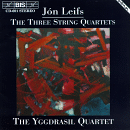
Readers may remember this writer asserting a while back when reviewing the symphonic drama Baldr, John Leifs (1899-1968) -- the acknowledged founder of the Icelandic school -- has composed some of the most radically strange and original music ever dreamed up. This is only partly so because he bases his idiom on still viable pre-Renaissance folk forms from his marginalized and runic native tradition. The truth is that this Leipzig-trained disciple of Busoni, a pure Aryan who, after a moderate success as a conductor and administrator in Germany, was forced back to his roots by the Nazis because of his Jewish wife, was a stubbornly idiosyncratic, even cantankerous, creator in the first place.
These three string quartets certainly bear this out. The first is a product of 1939, written just after his return to Iceland and before he had really perfected a mature nationalistic idiom. Cast in a single seventeen-minute movement and subtitled ``Mors et vita,'' the work already displays Leifs's almost obsessive interest in medieval ``organum'' techniques and his inherently gloomy temperament. His second essay in this form is much more distinctive and reflective of his later style. Written in the late 1940s in memory of his tragically deceased teenage daughter, it commemorates her life in three contrasted movements, entitled Childhood (an exuberant Scherzo), Youth (an ardent Allegro con espressione), and Requiem and Eternity (a long and piercingly transcendent meditation on grief and morality). In this work, Leifs's use of sustained open fifths reminds this listener of our own Roy Harris, who also was given to floating in a similar sea of resonant and slowly modulating chordal textures.
But it is in his third and last quartet of 1965 -- inspired by El Greco, in whom he professed to detect a Latin equivalent to the Nordic visionary spirit -- that Leifs finally comes fully into his own. This twenty-six-minute work of five movements of widely varying lengths is really more of a suite depicting specific paintings -- from the View of Toledo through The Resurrection -- and it packs an incredible punch of alternating rage, rumination, and release. Leifs's weightless harmonic condensation or cloudscape is abruptly slashed by an unexpected series of lightninglike staccato chords, particularly in the Toledo storm-scene or in the fury of Jesus driving the money-changers from the Temple. In the last two movements (``The Crucifixion'' and ``The Resurrection'') Leifs reveals an almost manic-depressive religious awareness, shifting suddenly from a despairing Adagio to a maniacal Allegro, and utilizing his typical kind of inchoate yet lapidary language -- a characteristic blend of the simplistic and the profound, the static and the frenetic, the barbaric and the cerebral.
The Yggdrasil Quartet of Sweden, a relatively new ensemble, meets the challenge they have set themselves with an almost complementary manic degree of focus and facility. BIS is to be congratulated for enhancing our knowledge of this most peculiar genius, whose music will be manna to both the discerning and the offbeat.
Paul A. Snook
|
|
|



